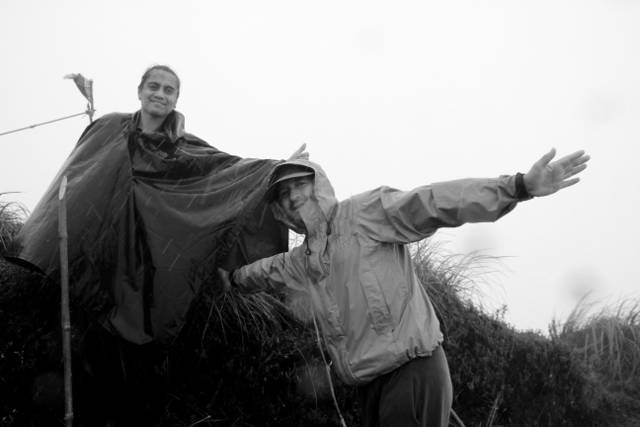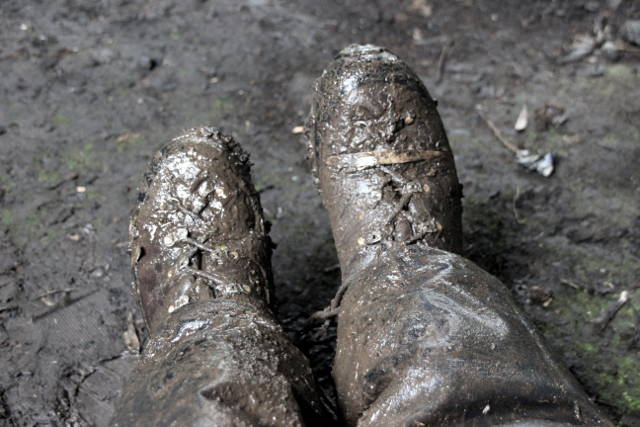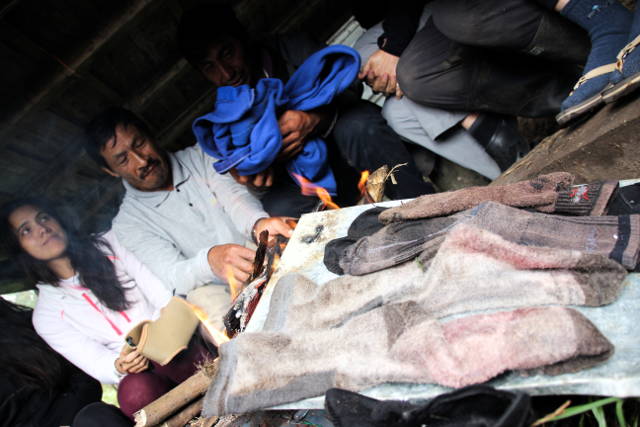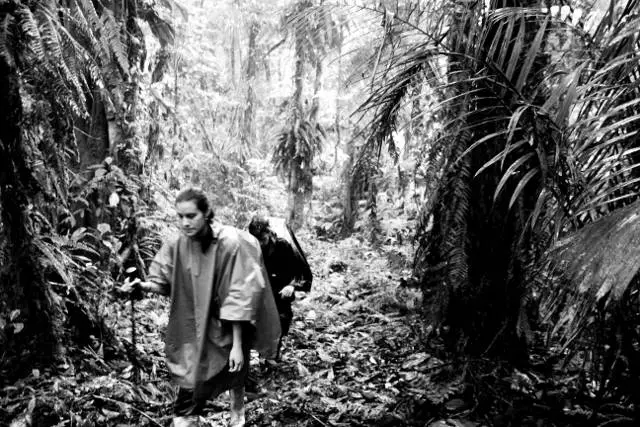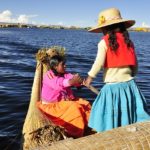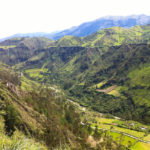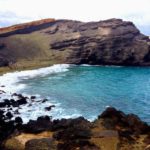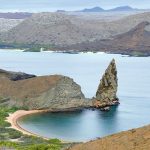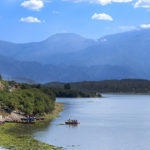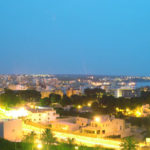As an Amazon Influencer, we earn from qualifying purchases you might make if you click any of the links on this page.
A wall of wind smashed against me, knocking a foot loose. I stumbled. Shards of volcanic rock danced down the flank of the mountain as my foot searched for a hold. I heaved myself up, squinting through the rain and hail. This was my experience hiking Sumaco.
Behind me, another hiker was shouting at me, but I couldn’t hear anything over the wind. His mouth was moving, but the wind was stealing the words the minute they left his tongue. He pulled himself up, and just inches from my face shouted, “We’ve got to go back!”
For a moment, I desperately wanted to give up trying to reach the peak.
“This is insanity, we could die up here,” he yelled.
Of course, he was right, but I didn’t know what to do.
This was the final ascent of a multi-day trek hiking Sumaco, a rarely visited volcano deep in the Ecuadorian Amazon.
The trek took us from the jungle floor to windswept highlands, and eventually the desolate peak. Our trip had started three days earlier in the village of Pacto Sumaco. The village was little more than a handful of shanties in a jungle clearing.
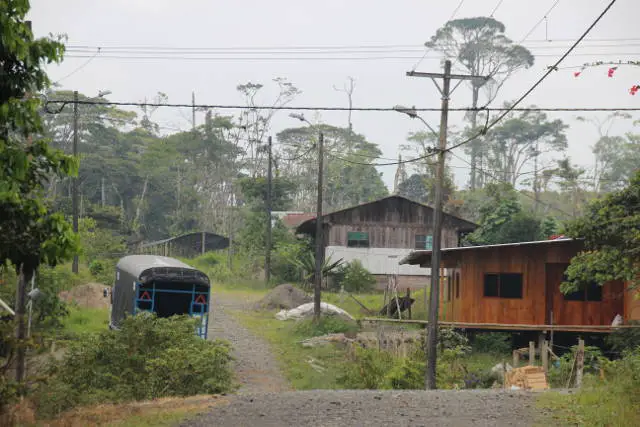
Day 1 of Hiking Sumaco: The Jungle, Mud and Rats
From the village, the trail was nothing more than a sunken trough of mud. At first, our group moved quickly, but the jungle heat started to weigh down on everyone within a few hours. Then just as I was getting used to the shin deep mud sucking at my boots, the trail slipped into a river. For the next few hours, we sloshed our way through a soup of muddy water until we reached the first refuge. At least we got to cool off.
Image Credit: Ryan Mallett-Outtrim
That night, we huddled around a campfire to dry our gear. As darkness set in, someone joked there were probably all sorts of animals in the refuge. The joke didn’t go down well, and a few people started speculating about how big Amazon rats could get. It didn’t take long for the paranoia to set in.
“Rat! A rat ran past my leg!” someone screamed. For a moment everyone was freaking out, flashing lights in every direction, looking for the rat. It never materialized, and eventually the group calmed down. I zoned out with a book, and stopped paying attention to the fireside conversation. Some time later, I looked up, and saw everyone was standing on top of their benches.
“Raaaaat……raaaaaaat,” someone was moaning. It only got worse when we went into the cabins to sleep. As I was drifting off, someone shrieked, claiming to have seen another of those elusive rats. At this point I was convinced there wasn’t a single rat at the campsite. It was just group-think, I reasoned. One person got skittish, which made everyone else skittish, creating a feedback loop, leaving everyone scared of the dark. I decided I wasn’t going to buy into it, and fell into a deep sleep.
“RAAAT!”
The scream yanked me from my sweet dreams.
“RAAAAAT!”
The cabin erupted with terror.
I groaned, “Please can we all just get some sleep and stop imagining – ” I cut myself off mid sentence in shock. Above me, I saw the biggest rat in the history of rats. It was morbidly obese, with a thick coat of shaggy hair, and a long, worm-like tail. Behind the behemoth rat, there was a small side-kick rat. While the bigger one had the face of a schoolyard thug, the other one had a petite, pointy nose and an bulging, innocent eyes. The odd pair calmly cruised out of the cabin, seemingly oblivious to the chaos below.
Day 2: Soggy Socks
By morning, nobody had slept another wink. As we started our second day of hiking, the trail quickly grew more difficult. In this part of the jungle, the trees were massive, silent behemoths. Their trunks were as solid as brick walls, and covered in huge, colorful fungi. As the trail got steeper, our group grew as quiet as the trees around us. The mountainside was slick with mud, while the occasional flat stretches were quagmires of stinking bog. By the end of the day, everyone was again soaked to the bone with sweat and rain. Luckily, we found enough dry wood to get a campfire going, and dry off our socks.
Image Credit: Ryan Mallett-Outtrim
Day 3: The Peak
At 4 am on the third day, we began our final ascent of hiking Sumaco to its peak. Most of our group had bailed by this point, leaving just five of us to set off in the pre-dawn darkness. At first, we were all in high spirits. The morning air was cool and refreshing, with the oppressive humidity of the Amazon now behind us. The jungle had given way to cloud forest.
Image Credit: Ryan Mallett-Outtrim
Cloud forests are common across Ecuador, clinging to the edges of the country’s highlands. Their omnipresent layer of fog endears them with a serene, magical atmosphere. During our hike, I was half expecting an elf or gnome to pop out of the fog at any moment. The other striking feature of the cloud forest was the moss. It was everywhere: shaggy heaps of it gripped the trees, while rocks were covered with a thin, greasy skin of the stuff.
Then we hit a wall.
A sheer wall of mud and foliage. The walk in the park had come to an abrupt end, and it was time to climb. Occasionally, there were large boulders and rocky outcrops to grip, but for the most part, the ascent was like climbing back up a mudslide. As we ascended, the forest canopy gave way, and the rain came pouring in. The climb became a battle with small rivers of water, and the wind began tugging at my sodden clothes. When I finally reached the top, an entirely new landscape was sprawled out ahead.
Looking below, I could see the forest below spread out to the horizon. Nothing but green.
Ahead, a thin trail wound its way through the paramo – a kind of high altitude plain. At this altitude, large plants struggle to grow, meaning we were totally exposed to the elements. As we got close to the peak, the wind became more persistent, growing to a screeching gale. At every step, it felt like the wind tried to yank my foot away from me. The rain and hail forced my head down, reducing the world to the next step, followed by another step, and another.
The flat plain morphed into a slope of crumbly volcanic rock. On either side, there were steep drops into the sea of gray fog. One slip, and there was no telling how far I’d fall. By this point, the group had split up, and there were just two of us together, battling our way on the final stretch.
“This is insanity, we could die up here,” the other hiker shouted.
I knew he was right. The weather had become almost impenetrable. Just standing up had become difficult. My desire to keep going was bleeding away by the second. I imagined arriving back home, having a hot meal and a cold beer.
“So are we turning back or what?” he asked.
“I erm … I want a pizza,” I shouted over the wind.
“What?”
“I mean, peak or death,” I said.
He shook his head and yelled “that’s crazy!”
Within moments, he had disappeared into the fog, and I continued alone. Soon, two more hikers caught up with me, including our group leader. Together, the three of us hauled ourselves up the final ascent. All of us were on the edge of total exhaustion. Staggering, I found myself on a small, flat landing. Ahead, the trail dissolved, and the terrain dipped down. Every direction was down. It was like a stab in the chest. I imagined myself easing my way down the slope in the wind. I started to worry again that I’d never reach the peak, and I’d never finish hiking Sumaco.
“Congratulations!” Our group leader said. For a moment, I was confused. Then it clicked, and I was almost delirious with joy. We had made it to the peak. We exchanged a few high fives, and the three of us shared a chocolate bar. Then, we turned around and began the grueling descent.
Image Credit: Ryan Mallett-Outtrim
How You Can Try Hiking Sumaco
As with all great trips, it’s the journey not the destination that matters. If you want to try hiking Sumaco for yourself, there are a few possible options. Firstly, actually getting to Ecuador is becoming easier by the day, thanks to a growing crop of discount flight options with the likes of LAN. Check out our flight search for more details.
I did the Sumaco trek with the Quito-based hiking club, Zona Verde. They offer trips for a fraction of the price of most tourism operators in Quito, and are extremely professional. The entire trip cost me just over $100. However, they mostly cater to Quito locals, and thus generally only run trips on weekends and public holidays. There are plenty of other tour operators from Quito, with a dozen or so hiking outfits clustered around the Mariscal district’s Plaza Foch, though most charge at least double Zona Verde’s rates for a trip like hiking Sumaco. One of the more well established operators is Gulliver Expeditions, though it’s easy enough to go door to door along Reina Victoria to compare prices.
A final option is to simply make your way to the trailhead, and try to hire a local guide. One possibility is to contact the Asociación de Turismo Pacto Sumaco (06 3018324 06 3018324), which can organize a guide for hiking Sumaco at around US$40 a day. This would be a much cheaper option than going with a guide from Quito, though transport can be tricky. You may have to take a bus from Quito’s Quitumbe terminal to Coca, where there are some limited options for transport to Wawa Sumaco. From there, you can hire a pickup truck for less than US$10 to Pacto Sumaco. Luckily, once you reach Pacto Sumaco things get a little more straight forward.
While hiking Sumaco, accommodation, for example, is easy. At the entrance to the village, the environmental ministry runs a cheap hostel that costs US$7 per person. If you’d rather a comfortable bed before your hike, the lovely Wild Sumaco Lodge is located just outside town. On the trail itself, you can crash in any of the network of basic refuges dotted along the trail. These refuges are extremely basic, but at least you shouldn’t need to carry a tent.
You will, however, need to bring all your own food while hiking Sumaco. Don’t worry too much about water, as there’s plenty of it on the trail, and all the refuges have tanks. As long as you have some purification tablets, you should have all the water you need. You’ll also need to bring along plenty of insect repellent, warm clothes for the summit and some solid rain gear. Rather than a gore-tex jacket, opt for a loose fitting poncho to cut down on sweat. Finally, many hikers use rubber boots on this trail to deal with the mud. I personally stuck with some waterproof leather hiking boots, and did just fine. However, if you do choose rubber boots, make sure you use some comfortable insoles and wear double socks. This will cut down on blisters dramatically.
Lastly, be prepared for mud, rain and pain. Hiking Sumaco is tough, and requires decent physical condition and some prior hiking experience. Bring a sense of adventure, and a willingness to push yourself.
Feeling a bit tired after your hike? Check out our guide to getting the most out of the luxurious hot springs of Banos!
Ryan Mallett-Outtrim is an independent journalist and travel writer based out of Puebla, Mexico. More of his work can be found at his blog, dissentsansfrontieres.com.

